Key takeaways:
- Electronic music labels significantly influence artists’ careers by providing support and shaping their sound, balancing artistic vision with commercial viability.
- Defining a clear artistic vision is essential for maintaining authenticity while navigating industry complexities and audience expectations.
- Finding a balance between creativity and market trends can enhance an artist’s work without sacrificing their unique identity.
- Collaboration and constructive feedback are crucial for artistic growth, enabling artists to refine their sound while staying true to their vision.
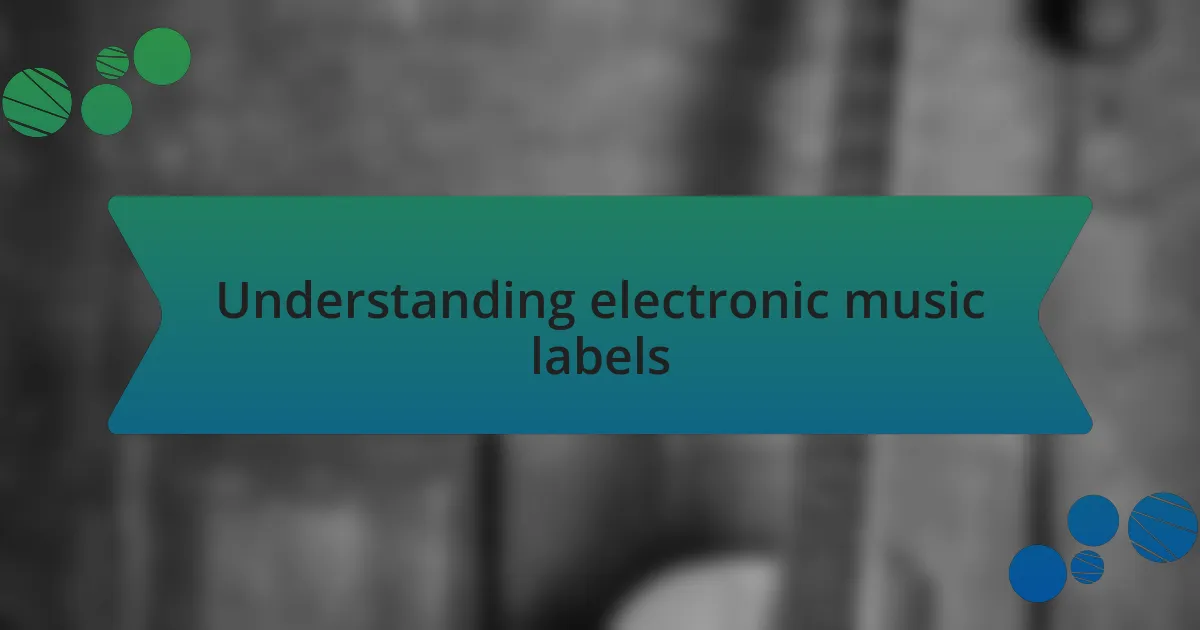
Understanding electronic music labels
Electronic music labels are unique entities that play a crucial role in the music industry. They not only support artists by providing resources and platforms for distribution but also act as curators, shaping the sound of electronic music in various subgenres. I remember the first time I discovered a small label that released underground tracks; it felt like unearthing hidden gems in a vast ocean of sound.
When I think about the relationship between labels and artists, it raises a compelling question: how much influence does a label truly have over an artist’s creative process? From my experience, the best partnerships often strike a balance where the label respects an artist’s unique vision while also guiding them toward ensuring commercial viability. There’s something exhilarating about collaborating with a label that gets your sound and helps amplify it to a wider audience.
The dynamics of electronic music labels are ever-evolving, influenced by digital platforms and social media. I’ve seen many artists thrive due to a supportive label that emphasizes community-building and engagement. It’s fascinating how a label can transform an artist’s career trajectory, creating opportunities that might have seemed impossible before. What pivotal moment in your artistic journey has shaped your perspective on the role of a label?
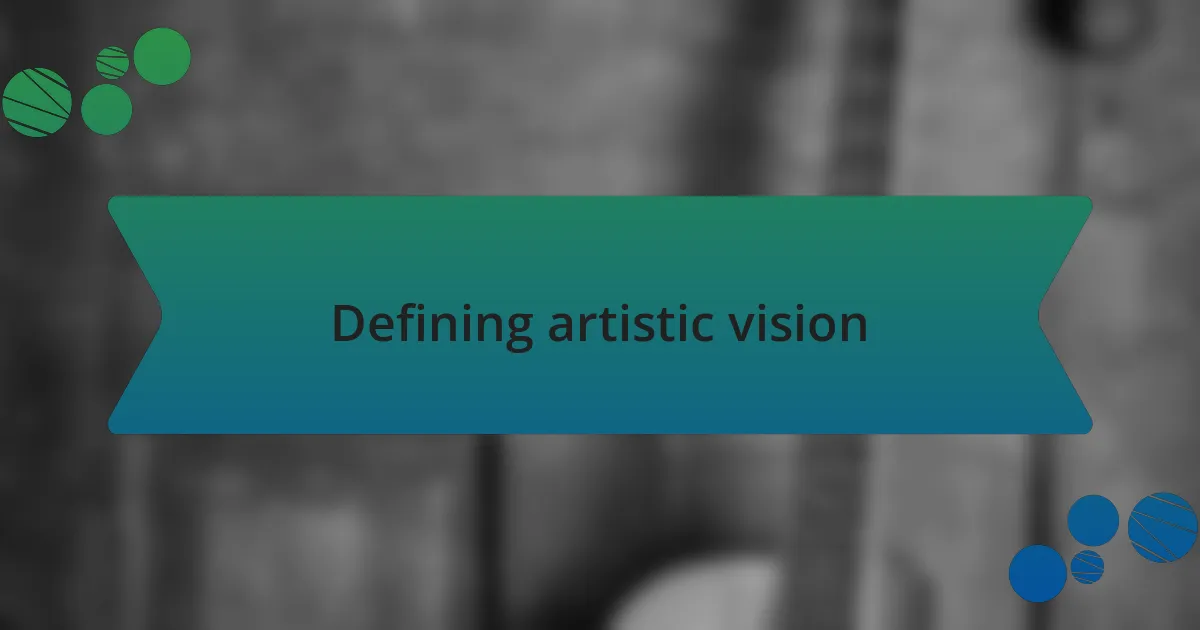
Defining artistic vision
Defining artistic vision is a deeply personal endeavor for any creator, especially in the realm of electronic music. For me, it involves an intimate understanding of the sounds and experiences that resonate within my core. I remember crafting a track that encapsulated my feelings on a rainy day; the resulting piece was layered with emotions that transformed simple notes into a powerful story. How do you channel your own experiences into compositions?
Artistic vision often acts as a guiding star for artists, illuminating their unique sound amid a sea of commercial trends. I find that it requires continuous reflection and experimentation to maintain authenticity. There’ve been times when I felt pressured to conform, but every time I leaned into my creative instincts, the results were not only more fulfilling but also surprisingly well-received by audiences. What aspects of your musical identity are non-negotiable for you?
Moreover, the clarity of one’s artistic vision can be pivotal in navigating the complexities of the music industry. I’ve witnessed firsthand how a clearly defined vision can lead to more meaningful collaborations and audience connections. When I collaborate with others, I often ask myself, does this partnership amplify my voice or dilute it? I believe that staying true to one’s artistic vision not only empowers the creator but also enriches the listening experience for fans.
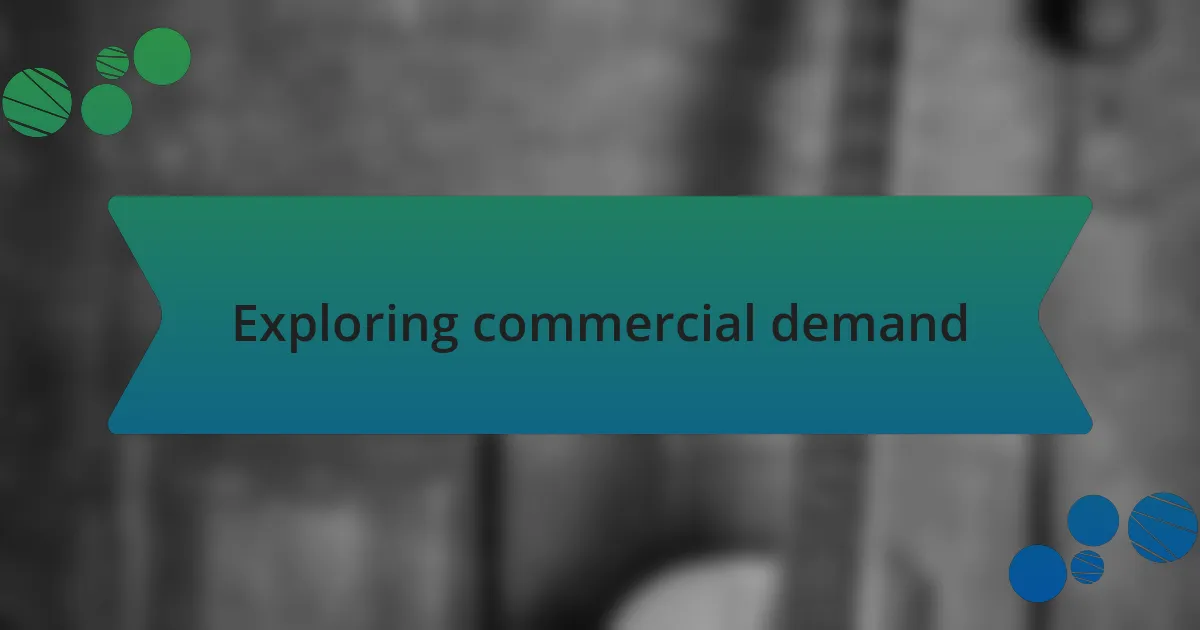
Exploring commercial demand
Exploring commercial demand in electronic music often feels like walking a tightrope. There was a moment when I released a track that was more aligned with current trends, thinking it would resonate widely. While the numbers were promising, I felt something was missing—a piece of my soul wasn’t in the music. Does commercial success always equate to personal fulfillment?
As I delved deeper into understanding audience preferences, I discovered that commercial demand can be a powerful ally. I remember hosting a listening session where fans shared their thoughts on a new beat. Their enthusiasm ignited a spark in me; it was a reminder that listening to the audience didn’t compromise my artistry—it enhanced it. How can we find that sweet spot between catering to our listeners and preserving our creative essence?
Navigating the music industry’s commercial landscape requires agility and awareness. There have been times I’ve adjusted my sound based on market feedback, but I always ensure these changes don’t overshadow my core identity. The joy comes when I weave in my artistic vision alongside what’s trending, creating something both marketable and genuine. What has your experience been with balancing your unique sound against the tides of commercial expectations?
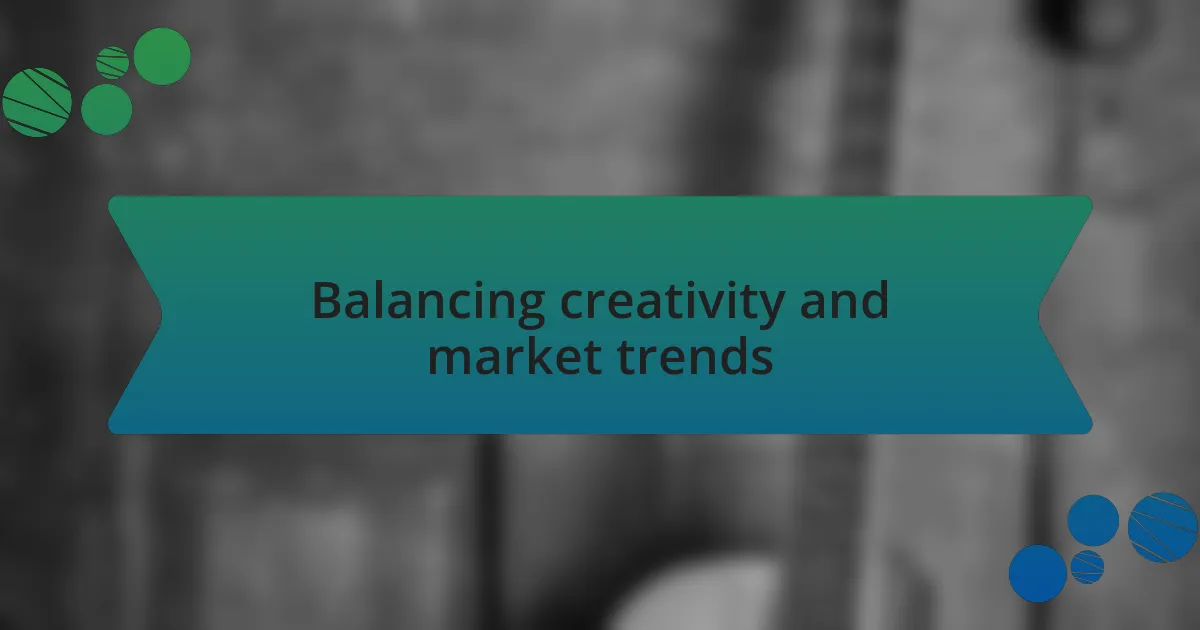
Balancing creativity and market trends
Finding the intersection between creativity and market trends can feel like trying to navigate an intricate puzzle. I vividly recall a project where I experimented with an unconventional sound that didn’t align with what was popular at the time. Initially, the reception was lukewarm, but as I refined the innovation, it captured attention; it was a rewarding reminder that sometimes, stepping outside the norm allows for genuine connections with listeners.
There have been moments where I hesitated to incorporate certain popular elements into my music, fearing it might dilute my vision. I chatted with fellow artists who shared similar concerns, and their experiences reassured me. Recognizing that embracing some trends doesn’t mean sacrificing authenticity has led me to explore new avenues that still resonate with my core self. How much of a risk are you willing to take in your art to see potential rewards?
Moreover, I’ve learned that market trends can act as a mirror, reflecting the emotions and needs of the audience. I recall adjusting one of my tracks after receiving positive feedback about a specific beat pattern. To my surprise, marrying that popular element with my unique style resulted in a piece that not only sold well but also felt inherently me. How do you integrate those feedback loops into your artistic journey without losing who you are?
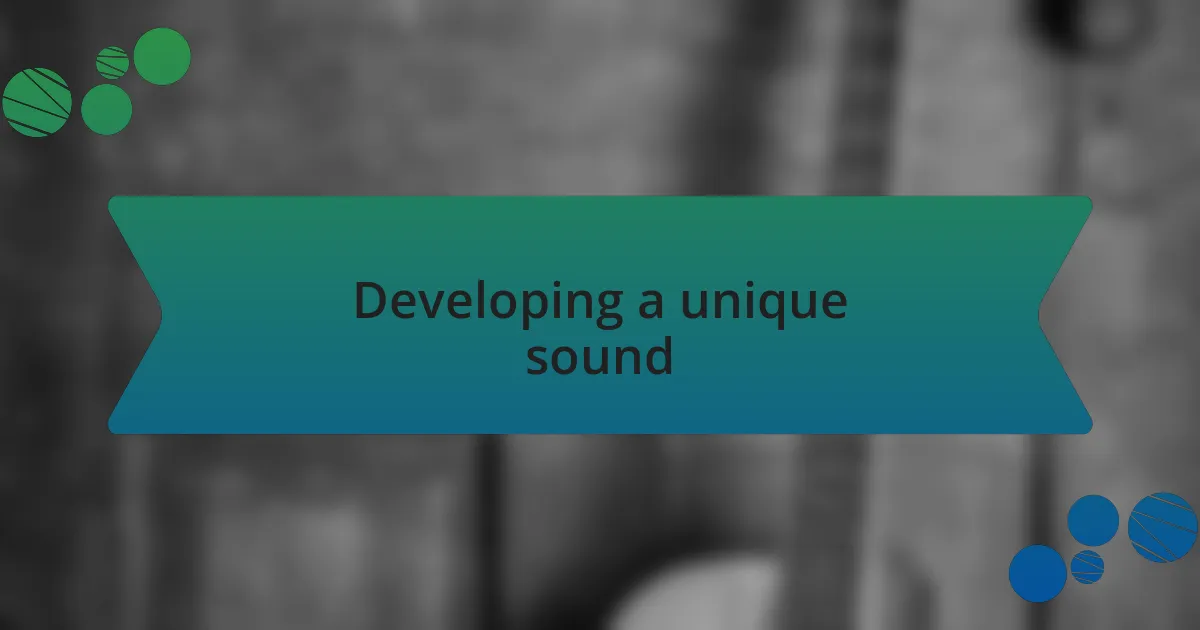
Developing a unique sound
Developing a unique sound is a journey that requires both self-discovery and experimentation. I remember diving into a project where I decided to blend traditional genres with electronic elements, creating something distinctly different. The process was exhilarating yet daunting, as I often questioned whether listeners would embrace this hybrid. That uncertainty, however, became part of the creative thrill.
As I honed this unique sound, I found myself revisiting my influences and inspirations, which helped ground my work. There were days when I felt overwhelmed by external expectations, yet reflecting on my favorite records reminded me that every groundbreaking artist once faced criticism. Have you ever felt the pressure to conform while creating? I often used those moments of doubt to fuel my determination, transforming challenges into stepping stones for my artistic evolution.
Listening to feedback has also been pivotal in this process. I recall a time when a fellow artist suggested incorporating ambient sounds into my track, and it completely altered my sonic landscape. Initially, I resisted, fearing it might stray too far from my intended direction. Yet, embracing that suggestion led to a richer listening experience, reminding me that collaboration can birth a sound that feels both unique and commercially appealing. How do you strike that balance between staying true to your vision and welcoming new ideas?
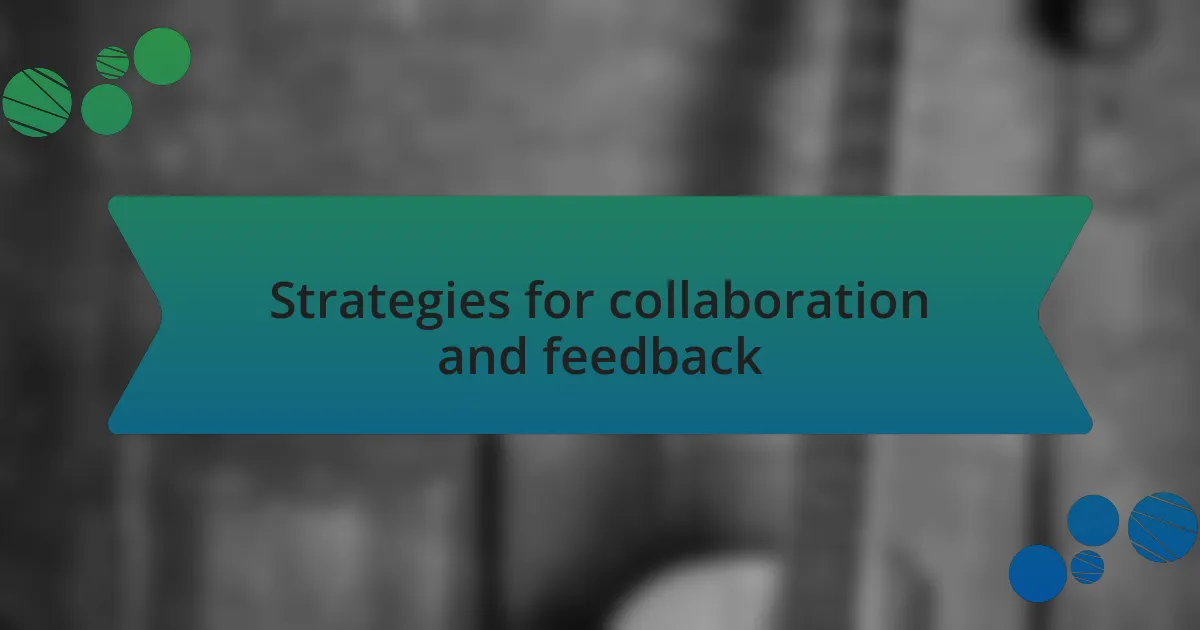
Strategies for collaboration and feedback
Engaging with other artists can be an invaluable strategy for cultivating creativity and achieving success. I once worked on a collaborative project that paired me with a talented vocalist. Throughout our sessions, we exchanged ideas openly, which sparked a series of innovative concepts I would have never considered on my own. Have you ever experienced that kind of collaborative synergy? It’s a magical thing when two distinct visions come together to create something more powerful.
Feedback is another crucial element in this mix. After releasing an initial version of my track, I organized a small listening party with fellow producers and friends. Their reactions provided insights I hadn’t anticipated; some suggested adjustments to the drop, while others pointed out moments that felt too cluttered. Their perspectives challenged me to rethink the arrangement, ultimately enhancing the track’s impact. Isn’t it interesting how an outside perspective can illuminate aspects of your work that you might overlook?
Lastly, I’ve learned that giving constructive feedback is just as important as receiving it. I once mentored an emerging producer who was struggling with confidence in his work. By carefully reviewing his tracks and highlighting both strengths and areas for improvement, I encouraged him to embrace his individuality while also considering how to meet listener expectations. Isn’t it rewarding to be part of someone else’s growth journey? That experience not only bolstered his confidence but deepened my own understanding of the balance between artistic integrity and commercial viability.
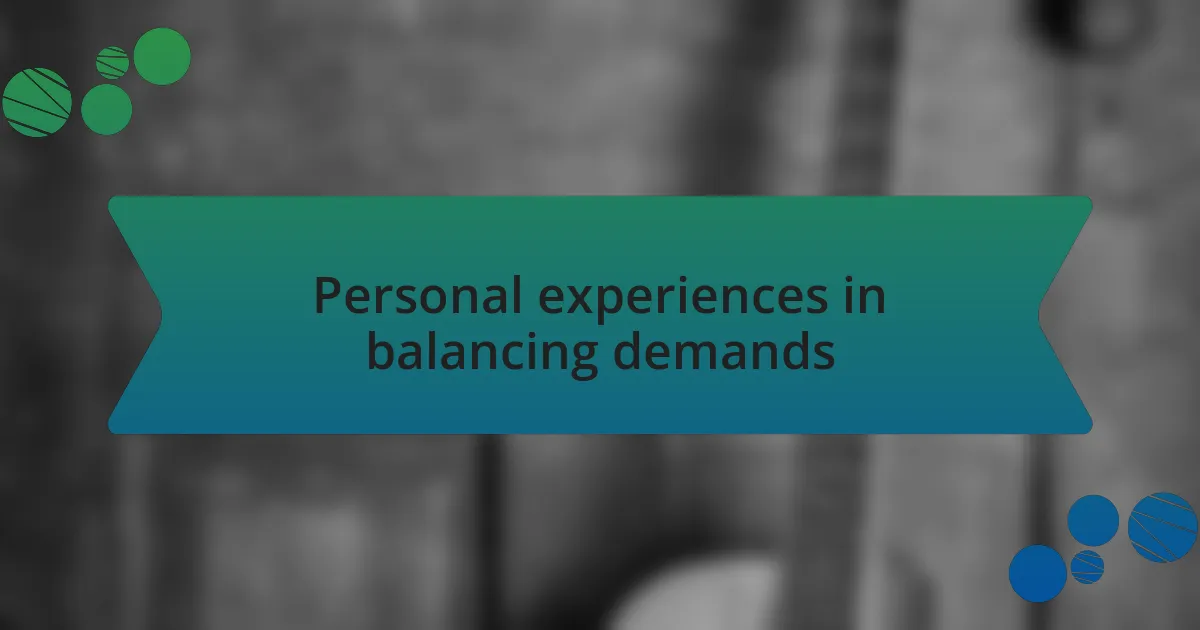
Personal experiences in balancing demands
In my own journey, I’ve faced moments where my artistic vision felt at odds with commercial expectations. I vividly remember a track I passionately created that experimented with unusual rhythms and sounds. While I was excited about its uniqueness, feedback from industry peers pointed out that it might alienate mainstream listeners. That push-pull dynamic can be frustrating, but it’s also an opportunity to grow, isn’t it?
One instance that stands out to me involved a remix I was working on for a well-known pop artist. I had envisioned an experimental take, filled with intricate layers and unexpected transitions. However, the label’s feedback suggested streamlining the approach to retain the essence of the original hit. This encounter taught me the value of compromise. It was about blending my innovative spirit with the need to reach a wider audience. Have you ever had to navigate that tightrope walk between your creativity and what others expect?
I’ve learned that striking the right balance often requires me to reflect on my own priorities. I once committed to a project that leaned heavily into commercial appeal, thinking it would grant me more artistic freedom in the long run. I realized, however, that sacrificing my style yielded hollow satisfaction. This taught me that aligning my artistic goals with commercial demands doesn’t mean losing authenticity. It’s a delicate dance, but one that can lead to truly fulfilling creative expressions. How do you evaluate when to stand firm and when to adapt in your own work?